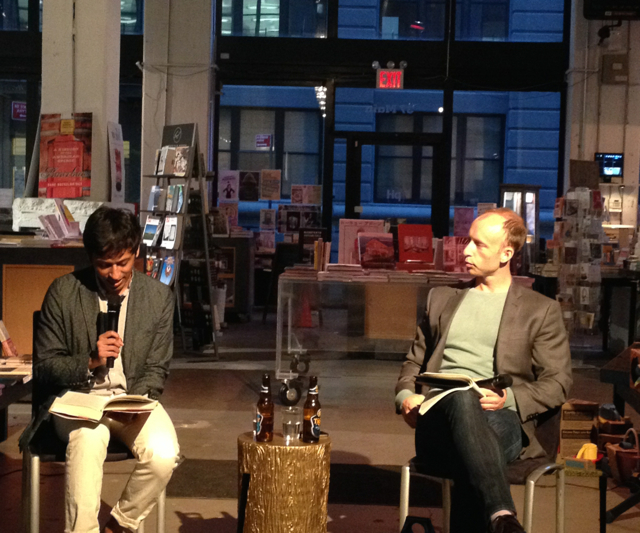
Over the last century, labor has shifted away from a manual as a dominant form towards clerical office work. Nikil Saval’s book, Cubed, traces the history of this evolution and explores the limits of the office as a place for work. He celebrated the launch of the book at Powerhouse Arena with Chad Harbach, editor of the journal n+1 and author of The Art of Fielding (2011).
Saval opens the evening by a selection from the book to set up the history of labor. The office clerk rises in the nineteenth century as a compliment and parasite to the manual laborers producing goods, farming land, or constructing physical objects. Since then, employers have sought ever less human conditions for their workers, often under the guise of improving workplace conditions. The cubicle is birthed in the middle of the twentieth century as a solution, but quickly morphs into a new problem.
After Saval reads, Harbach begins by explaining that the first time he met Saval was in June of 2005. The summer intern class for n+1 that year included Saval. They met in the offices of the magazine, then the dining room of the house Harbach and co-founder Keith Gessen shared. A few days after the intern orientation, Saval called to say he had landed a real job in a real office.
The office job–working at a major publisher–proved thrilling for Saval at first. “I never had a cubicle of my own,” he jokes, saying that it excited him and he spent hours pinning things to his new cubicle walls.
“Eventually I grew tired of it…I realized the cubicle wasn’t that exciting.”
The job disappointed him, and he directed his anxiety towards the cubicle. He saw the cube as the object of his distress.
Harbach interjects: one of the amazing things about this book is that no has written it yet. He asks where the inkling for the book came from.
Saval changed jobs. He left the big publisher for a smaller one. But that also meant he had a smaller cubicle. He worked longer hours. He constantly spent his time looking over his shoulder–literally–because his boss’s office was situated directly behind him. During this time, he began looking more closely at his cubicle.
Harbach explains that the book started off as an essay in n+1. He looked back through his email history of 2007 when he and Saval discussed the original essay and laid out the original history of the office. “Everyone just wants to talk about the cubicle,” Harbach says.
“I developed an unhealthy obsession with the man [Robert Propst],” Saval says. Propst invented the Action Office, a design that eventually evolved into a cubicle. Propst set out in the 1950s to fix the office. Before then Propst, offices drew on the factory as a model. Large open layouts with rows of desks organized the space. Propst, employed by Herman Miller, wanted to fix the problem of these open layouts.
The original Action Office proved too expensive. It presciently did include a standing desk. Action Office II included flexible walls covered in fabric set at 120 degrees. It proved highly successful, but as imitations appeared, the elements that improved life for office workers were cut.The angles shrunk to square corners to cram more people into smaller spaces ultimately saving money.
No office can maintain the relationship between manager and worker, Harbach says. He adds that the story of of Cubed is more the history of the white collar worker.
Saval explains that the white collar worker often earns less than the blue collar counterpart, and yet the white collar worker never has developed the structures in place to support the blue collar labor. Partly these differences hinge on perceptions. White collar workers deal with cleanliness, they never come home smelling like their jobs. Mainly though the difference is the perception of advancement. Office clerks have long believed they could one day move to the managerial or partnership role of the business. Early on, this route to success remained true. Big business has helped make that kind of advancement impossible, Saval says, because the base of the pyramid has grown faster with fewer positions on top available. The expectation is eventually the office worker will move to management, but it remains an impossible goal.
Harbach shifts the conversation by saying Saval comes down hard on sitting.
“Sitting is really bad for you,” he says, laughing that the audience has voluntarily sat down for an hour long book discussion. Basically, when asking someone to have a seat, Saval says, you are inviting them to die.
Saval traveled to many offices during the course of writing the book. “Office tours are weird,” he says. They are like touring someone’s apartment. He says the most interesting offices he found were in the Netherlands. They had elaborate ideas about work. One of the people who spoke to in the Netherlands seemed to think that the ability to choose an office desk was the long term of Karl Marx.
Saval outs himself as a Marxist but insists his goal was never to write a left leaning criticism of the workplace. He mostly wanted to follow the history of the experience of the office.
“It was never a good place to do work. It was mostly a place to not do work,” Saval says.
Harbach asks about the seeming economic imperative to build more offices.
Saval responds that this is a human death drive. “There is a weird desire to fill the world with offices…its not sustainable,” he says. The real imperative should be to make life better.